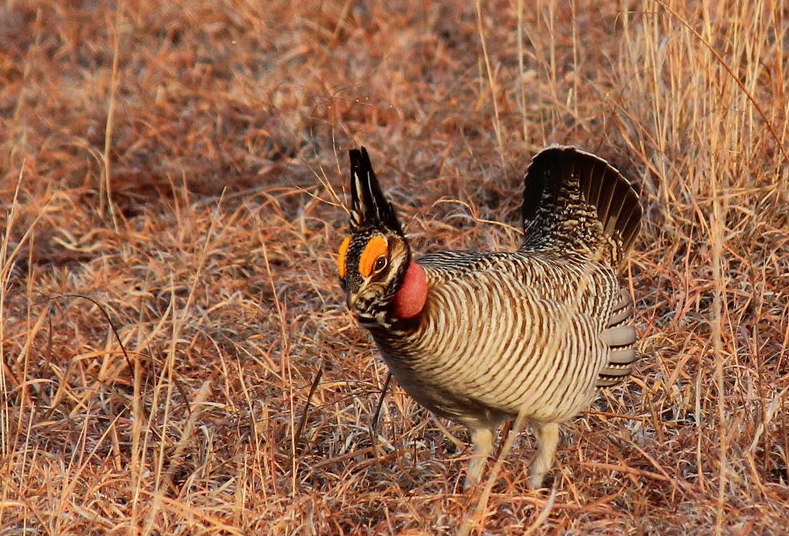
The placement of the lesser prairie chicken by the U. S. Department of the Interior’s Fish and Wildlife Service (FWS) on its “endangered species” list concerns some Lea County officials, ranchers, oil and gas companies and members of the public.
After nearly 30 years of debate and litigation, the federal agency’s decision became effective on March 27, in accord with the U. S. government’s Endangered Species Act. In response to the federal government’s action, Lea County Commissioners last month unanimously approved a resolution that opposes the listing and suggests that the FWS rethink its decision.
Lea County Commission Chairman Dean Jackson is stated, “This eventually will affect the oilfield, agriculture, utilities…. This is all government overreach in my opinion.” Commissioner Pat Sims agrees. Voicing his opinion at a recent commission meeting, Sims said, “I am suspicious. I don’t think this has anything to do with a little bird. I think it is all about shutting down the oil and gas industry and our agriculture industry.”
Current Battle Nothing New
The current battle about the lesser prairie chicken is nothing new. It started in 1995 when the Center for Biological Diversity first asked the FWS to protect the species. Through the years providing such requested protection to the bird by the federal government has remained a concern to many Lea County folk.
In June of 2014, Lea County Commissioners joined a lawsuit as plaintiffs, opposing FWS’s listing of the lesser prairie chicken as “threatened”. Gregg Fulfer, Lea County Commission’s chairman at that time, “…said the county entered the lawsuit because the commission believes the federal government’s results on the chicken’s threatened status is inconclusive,” states an AP article published in the Lubbock Avalanche-Journal. Fulfer is quoted as stating, “We discussed all their science and showed in a lot of different ways how their science they were using was not credible.” In 2015 the United States District Court Western District of Texas, Midland-Odessa Division agreed and granted a summary judgment in favor of the plaintiffs. In a press release (PDF) issued by the Lea County Commission, Fulfer said in support of the Court’s decision, “This listing would be extremely detrimental to Lea County resulting in the loss of a critical number of jobs.”
In 2016, the Center for Biological Diversity and its allies pushed even harder to protect the bird. They asked for the “threatened” listing to be upgraded to “endangered”. The federal government did not respond in a timely manner to the conservationists’ request, causing the group to institute a lawsuit in 2019. In their lawsuit the advocates argued that the federal government was not doing enough to protect the bird. The lawsuit led to the 2022 rule, which became effective only two weeks ago. Through all of this, county officials, the oil and gas industry, ranchers and other Lea County stakeholders have voiced opposition to adding the bird to the FWS’s “endangered species” list.
In a recent press release Michael Robinson, senior conservation advocate for the Center for Biological Diversity, said about the “endangered” classification, “We wish that the Fish and Wildlife Service hadn’t delayed this protection for 27 years, because quicker action would have meant a lot more Lesser Prairie Chickens alive in a lot more places today.”
Different from Domestic Chickens
Different from but in the same family as the regular domestic chicken, the lesser prairie chicken, according to the Audubon Society, “now only exist on about 10% of their historic range,” states a KRQE news report. “Mapping from the U.S. Department of Agriculture’s Natural Resources Conservation Service (NRCS) shows that they once occupied large swaths of eastern New Mexico, western Texas, the Oklahoma panhandle, southwest Oklahoma, and southeastern Colorado, [as well as Kansas]. Now, they’re found in patches throughout that territory.” They have been broken into two Distinct Population Segments by the FWS – the northern, that includes Lea County, where the little bird is now listed as “endangered” and the southern where the species is categorized as “threatened”.
The Center for Biological Diversity credits the decline of the lesser prairie chicken to the “degradation and fragmentation of the southern Great Plains.” The Center’s press release states, “Conversion to crops, cattle grazing, the raising of powerlines and telephone poles, oil and gas drilling, and the incursion of woodlands — as well as drought and high temperatures linked to global warming — all harm the bird.”
FWS biologist Clay Nichols says that “the bird is an indicator of ecosystem health and when the ecosystem suffers, so does the local economy,” states an article posted at NMPoliticalReport.com. FWS officials add, “…there are ways that energy development can continue in compliance with the protections the bird is receiving.”


